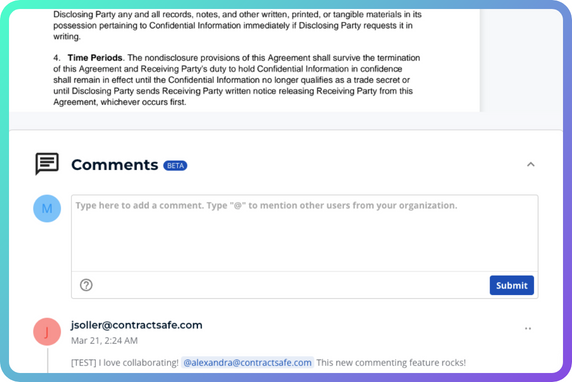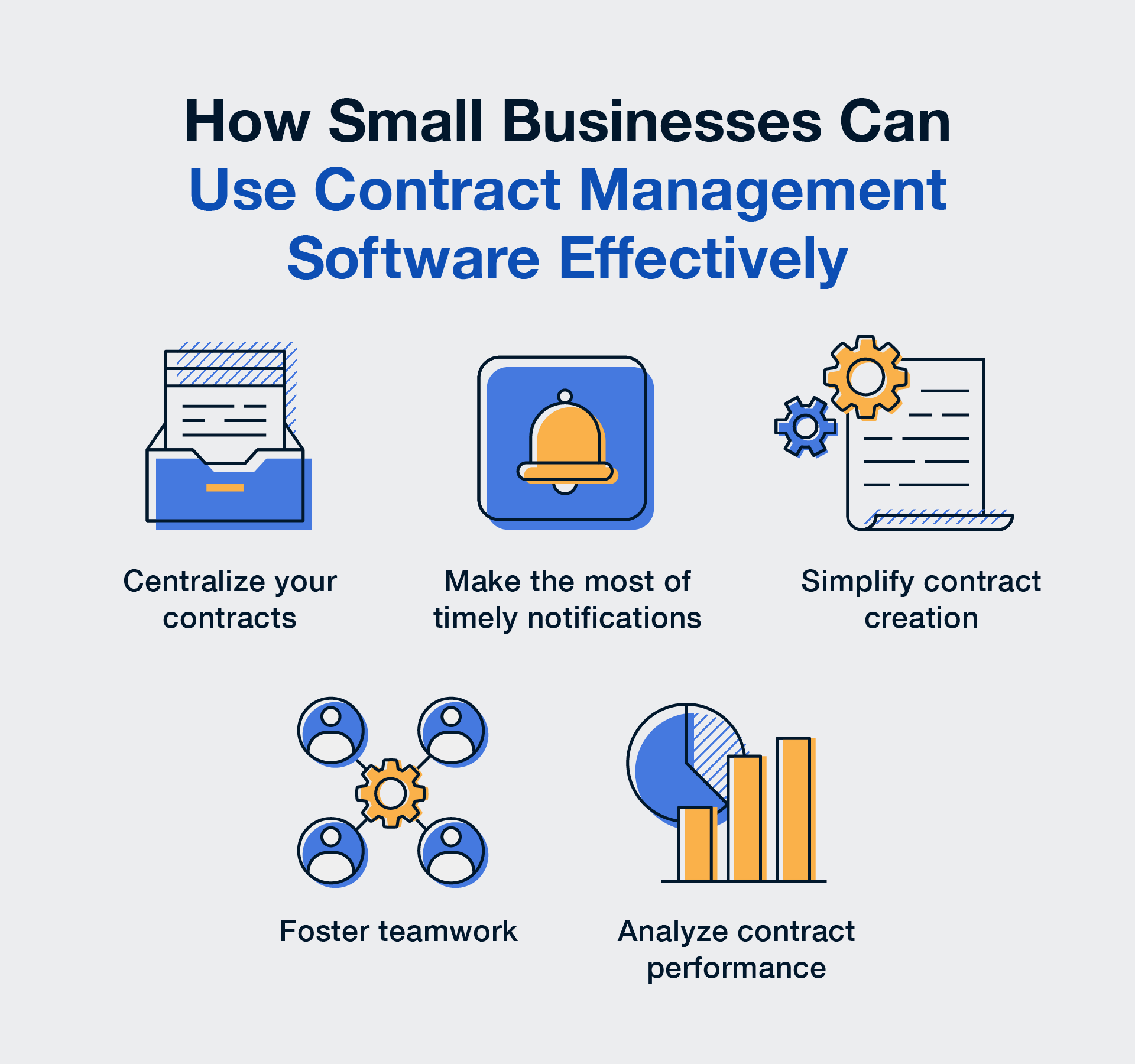The terms "contract administration" and "contract management" are often mistakenly used interchangeably, blurring the lines between two distinct yet interconnected stages in the lifecycle of a contract.
This common mix-up does a disservice to the nuanced complexities and unique contributions of each phase.
In this guide, we're setting the record straight.
We'll first explore contract administration — the careful drafting, detailed planning, and foundational setting that precedes any contract's birth. Then, we shift focus to contract management — where these well-laid plans are brought to life, navigated, and adapted through the ever-evolving landscape of business needs and relationships.
By understanding each process, you can elevate your approach to contracts and learn how to use contract management software to take your business to the next level.
Table of Contents:
What Is Contract Administration?
How to Prepare a Contract Administration Plan
What is the Difference Between Contract Administration and Contract Management?
How to Transition from Administering to Managing Contracts
How ContractSafe Can Help You Manage Contracts Effectively
TL;DR
- Contract administration concentrates on the initial setup of contracts, laying the groundwork for clear terms and expectations.
- Contract management takes a comprehensive approach, overseeing the contract throughout its entire lifecycle, from creation to renewal.
- Transitioning from administration to management in contract handling can significantly boost operational efficiency and strategic outcomes.
What Is Contract Administration?
Contract administration is the foundational stage of any contractual agreement. It includes all of the planning and prep work a contract needs before it's signed, ensuring everything is set for smooth operation.
Key responsibilities of a contract administrator include:
- Pinpointing the goals and aims of the contract to guide its creation
- Clarifying the extent of work, deliverables, and timelines to manage expectations
- Detailing what each party is responsible for to avoid misunderstandings
- Setting timelines for various phases of the contract for timely execution
- Crafting the initial contract document, which forms the legal backbone of the agreement
Contract administration helps get all the details right from the start, setting the stage for a successful and dispute-free relationship between the parties involved.
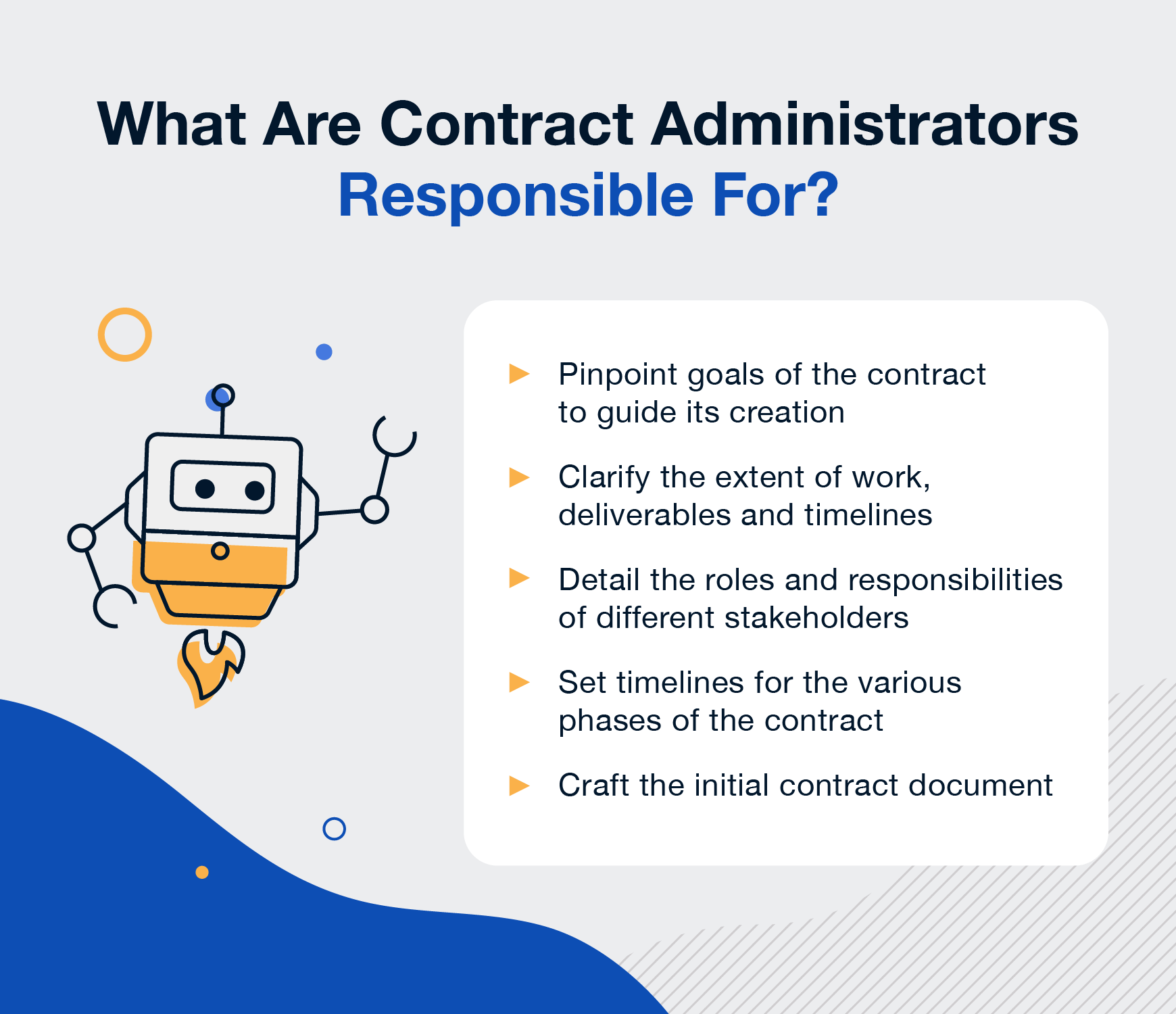
How To Prepare a Contract Administration Plan
Preparing a contract administration plan means thoroughly and thoughtfully addressing all the little details that go into writing a contract.
Here are a few steps you can take to write a successful contract administration plan:
- Define contract objectives and scope: Start by detailing the contract's goals and expected outcomes, focusing on operational and performance aspects. Specify the work scope, deliverables, and timeframes to set clear expectations and prevent misunderstandings.
- Identify key stakeholders and roles: Identify all parties involved in the contract and define their roles and responsibilities. This establishes a clear operational structure and ensures efficient contract management.
- Develop performance monitoring criteria: Create measurable performance indicators to assess the contract's progress and success. These criteria should evaluate work quality, timeline adherence, and compliance with terms.
- Plan for risk management: Look for potential risks like delays or quality issues and develop strategies to mitigate them. Proactive risk management maintains the contract's integrity.
- Establish communication protocols: Define clear communication channels and protocols for updates, problem-solving, and decision-making. Determine the frequency and format of reports and meetings to keep stakeholders aligned.
- Outline procedures for amendments and dispute resolution: Set up structured processes for handling contract amendments and resolving disputes. This ensures adaptability and maintains harmony among parties.
- Review and update the plan regularly: Conduct regular reviews of the contract administration plan to ensure its effectiveness and relevance. Be flexible in updating the plan to reflect changes in project execution or stakeholder needs.
Remember, a strong contract administration plan is just the start. The real efficiency and strategic advantage come when you evolve into comprehensive contract management.
What Is the Difference Between Contract Administration and Contract Management?
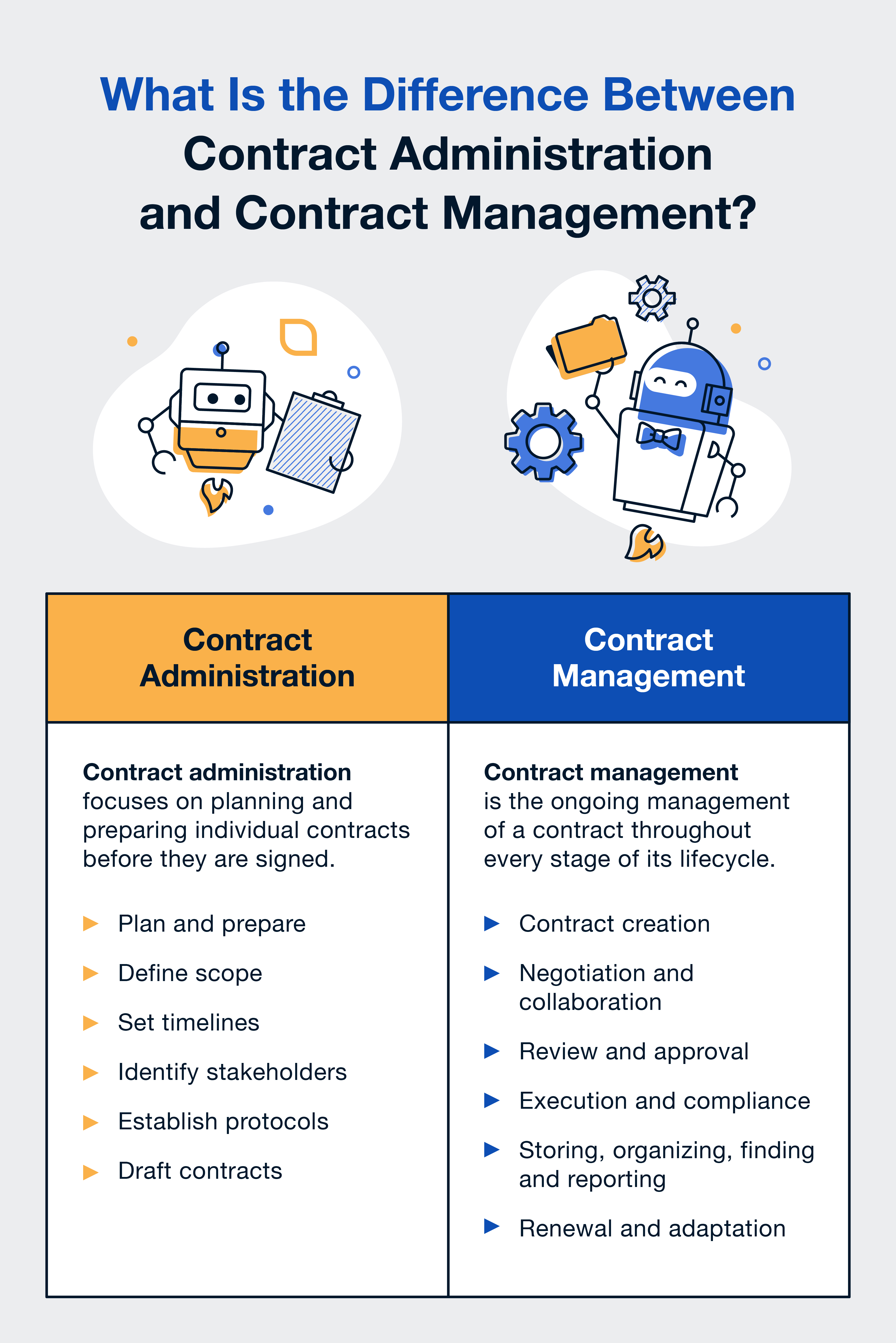
While contract administration focuses on setting up a contract correctly, contract management involves the broader spectrum of managing the contract throughout every stage of its lifecycle. This includes creation, negotiation, review, execution, ongoing management, and renewal.
It’s a more holistic approach, ensuring the contract adapts and continues to deliver value throughout its duration.
Key Activities
While there is a little bit of overlap between contract administration and contract management, it’s important to understand what each term entails.
Contract administration is all about laying the groundwork for a contract, focusing on defining objectives, establishing scope, avoiding risks, setting timelines, and, of course, drafting the initial agreement.
Contract management, on the other hand, is a more expansive and dynamic process that covers the entire contract lifecycle.
Contract management includes:
- Writing and personalizing a contract to suit its goals and obligations
- Negotiating and collaborating with stakeholders and counterparties to guarantee everyone is on the same page
- Facilitating internal review and approval processes to avoid delays and ensure accuracy
- Overseeing contract performance and ensuring all parties adhere to the terms
- Maintaining compliance with regulatory standards
- Assessing how well the contract is meeting its objectives and the needs of the parties involved
- Deciding the future course of the contract based on its performance and relevance
While contract managers pick up where administrators left off, their responsibilities also extend beyond the scope of individual contracts to encompass the oversight of an entire database.
This approach enables organizations to organize, secure, and report on contracts en masse, leveraging technology to streamline processes and enhance decision-making capabilities.
They adapt to changes, manage challenges, and ensure the contract continually serves its intended purpose and aligns with evolving business goals.
Roles and Responsibilities
The seamless transition from contract administration to management is underpinned by distinct roles and responsibilities.
Contract administrators focus on the initial phase, where their primary role is to set the contract on the right course. They’re responsible for creating a contract’s framework and foreseeing everything that could happen. Armed with this information, they can pass the baton to contract management.
Contract managers hit the ground running. Their role expands into dynamically managing the contract, ensuring it remains effective and responsive to changing conditions and requirements.
As part of their expansive role, contract managers also navigate the complexities of managing an extensive portfolio of contracts. This involves utilizing contract management tools to organize, track, and analyze contracts across the organization, ensuring a secure and efficient handling of the entire contract database.
Impact and Strategic Importance
The strategic importance of these roles is reflected in their impact on the contract's success.
Contract administration is vital in setting a clear, solid foundation. It’s the bedrock of the contract’s success, ensuring initial clarity and alignment with objectives.
Contract management is about the evolution and adaptation of the contract over time. Its strategic value lies in its ability to guide the contract through changing landscapes, continually aligning it with long-term business goals and market dynamics.
The strategic significance of contract management tools becomes evident in their capacity to handle contracts not just on an individual basis but across the entire organizational spectrum.
These tools empower businesses to maintain a macro-level overview by providing a centralized platform for organizing, securing, and reporting on an extensive array of contracts.
This is pivotal for informed decision-making, risk management, and ensuring compliance across all contractual agreements.
How To Transition From Administrating to Managing Contracts
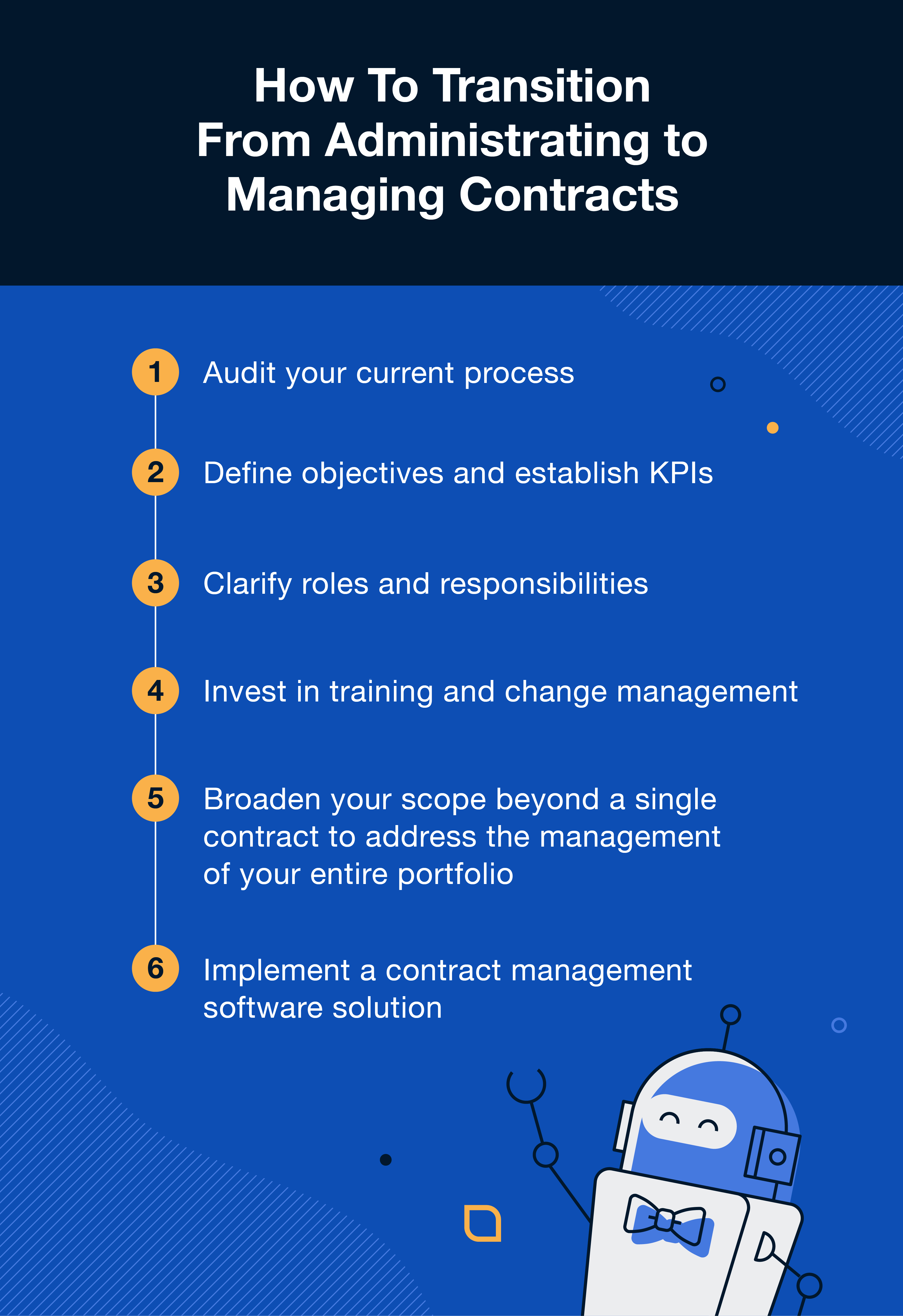 Transitioning from contract administration to management is a move that can significantly impact your organizational efficiency and contract effectiveness.
Transitioning from contract administration to management is a move that can significantly impact your organizational efficiency and contract effectiveness.
Here are a few steps you can take to ensure a smooth transition as you implement a contract management solution:
- Audit your current process: Start by evaluating how you currently manage your contracts. This involves assessing your existing systems and identifying where most of your contracts are in their lifecycle. Understanding your current state is critical for mapping out a successful transition.
- Define objectives and establish KPIs: Set clear objectives for what you aim to achieve with the transition. Establish key performance indicators (KPIs) to track the progress of moving from administration to management. This step will help you measure the success of your transition and ensure alignment with your organizational goals.
- Clarify roles and responsibilities: Outline what will happen at each stage of the transition and who will be responsible for each task. This clarity is essential for a smooth changeover, ensuring everyone involved understands their role in the process.
- Invest in training and change management: The shift from administration to management often requires new skills and processes. Invest in training your team, including both contract managers and administrators, on new processes. Additionally, a well-structured change management plan can help highlight the benefits and improvements this new approach brings, easing the transition.
- Implement a contract management software solution: The right technology can make a world of difference in this transition. Implementing the best contract management software solution that aligns with your organizational needs can streamline your processes, enhance compliance, and improve overall contract lifecycle management.
See How ContractSafe Can Help You Manage Contracts Effectively
In contract management, having the right tools at your disposal is a necessity — and ContractSafe was designed with exactly that in mind.
ContractSafe boasts a powerful yet accessible suite of tools tailored to meet your business where it’s at right now.
Take advantage of features like:
- Alerts and reminders: Ensure you never miss a critical deadline again.
- Centralized repository: Keep your valuable contracts safe but accessible, streamlining retrieval and management.
- Contract tracking: Gain a comprehensive view of all your contracts at a glance.
- Integrations: Incorporate your favorite tools into your contract workflow without hassle.
- [AI]ssistant: Leverage the power of AI to save time and simplify your most monotonous tasks.
- Templates: Kick-start your contract creation with customizable templates to ensure your documents are standardized and include all the details important to your business’s success.
By incorporating ContractSafe into your contract management strategy, you empower your team with the tools they need for effective oversight, strategic decision-making, and streamlined operations.Want to see it in action? Schedule a demo today!
